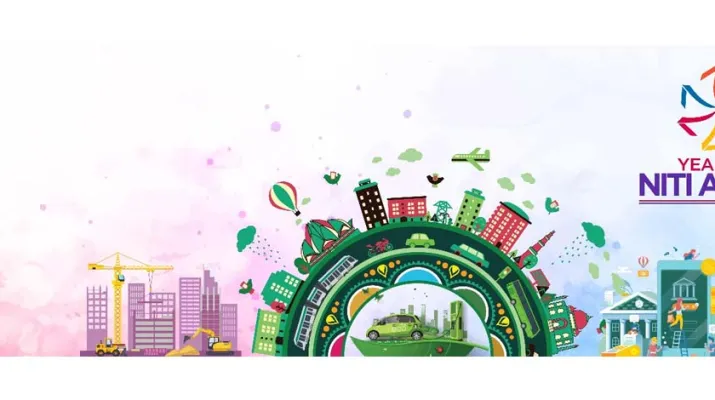NITI Aayog Unveils Automotive Sector Report

NITI Aayog has launched a comprehensive report titled “Automotive Industry: Powering India’s Participation in Global Value Chains,” aimed at positioning India as a significant player in the global automotive market. The report, presented by Vice Chairman Shri Suman Bery, alongside key members of NITI Aayog, highlights the current landscape of India’s automotive sector, its challenges, and the opportunities that lie ahead. With a focus on strategic interventions, the report outlines a roadmap for enhancing India’s competitiveness in the automotive industry.
Global and Indian Automotive Landscape
In 2023, global automobile production reached approximately 94 million units, with the automotive components market valued at around USD 2 trillion. India has established itself as the fourth-largest automobile producer globally, following China, the USA, and Japan, with an annual output of nearly 6 million vehicles. The Indian automotive sector has made significant strides in both domestic and export markets, particularly in the small car and utility vehicle segments. Supported by initiatives like ‘Make in India’ and a cost-competitive workforce, India is positioning itself as a manufacturing and export hub for automobiles. However, despite these advancements, India holds only a modest share of about 3% in the global automotive component trade, which amounts to approximately $20 billion.
Emerging Trends in the Automotive Sector
The automotive industry is currently experiencing a transformative shift towards electric vehicles (EVs). This change is driven by increasing consumer demand for sustainable mobility, regulatory pressures to reduce carbon emissions, and advancements in battery technology. As a result, global EV sales have surged, reshaping the manufacturing landscape. Battery manufacturing hubs are emerging in regions such as Europe and the U.S., leading to increased investments in lithium and cobalt mining, which are essential for EV production. These developments are altering traditional supply chains and creating new opportunities for collaboration and competition.
Simultaneously, the rise of Industry 4.0 is revolutionizing automotive manufacturing. Technologies such as Artificial Intelligence (AI), Machine Learning (ML), the Internet of Things (IoT), and robotics are enhancing production processes. These advancements improve productivity, reduce costs, and enable greater flexibility, fostering new business models centered around smart factories and connected vehicles.
Challenges Facing India’s Automotive Sector
Despite its position as the fourth-largest automobile producer, India faces significant challenges in the automotive sector. The country holds a mere 3% share in the global automotive component trade, primarily dominated by engine components, drive transmission, and steering systems. India’s share in these high-precision segments is notably low, ranging from just 2-4%. Operational costs, infrastructural gaps, moderate integration into global value chains (GVC), and inadequate research and development (R&D) expenditure hinder India’s competitiveness on the global stage.
Proposed Interventions for Growth
NITI Aayog’s report outlines several strategic interventions aimed at enhancing India’s global competitiveness in the automotive sector. These interventions are categorized based on the complexity and manufacturing maturity of automotive components.
Fiscal Interventions
- Operational Expenditure (Opex) Support: Focus on scaling up manufacturing capabilities, particularly in capital expenditure for tooling, dies, and infrastructure.
- Skill Development: Initiatives to build a talent pipeline essential for sustaining growth in the sector.
- R&D, Government-facilitated IP Transfer, and Branding: Providing incentives for research and development, enhancing international branding, and empowering MSMEs through intellectual property transfers.
- Cluster Development: Encouraging collaboration between firms through common facilities such as R&D and testing centers to strengthen the supply chain.
Non-Fiscal Interventions
- Industry 4.0 Adoption: Promoting the integration of digital technologies and enhanced manufacturing standards to improve efficiency.
- International Collaboration: Encouraging joint ventures, foreign collaborations, and free trade agreements to expand global market access.
- Ease of Doing Business: Simplifying regulatory processes and improving business conditions for automotive firms.
Vision for 2030
NITI Aayog envisions a robust automotive sector in India by 2030, with automotive component production projected to grow to $145 billion. The report anticipates that exports will triple from $20 billion to $60 billion, resulting in a trade surplus of approximately $25 billion. This growth is expected to increase India’s share of the global automotive value chain from 3% to 8% and create 2-2.5 million new jobs, bringing total direct employment in the sector to between 3 and 4 million.
For further details, the full report can be accessed here.
Observer Voice is the one stop site for National, International news, Sports, Editor’s Choice, Art/culture contents, Quotes and much more. We also cover historical contents. Historical contents includes World History, Indian History, and what happened today. The website also covers Entertainment across the India and World.

